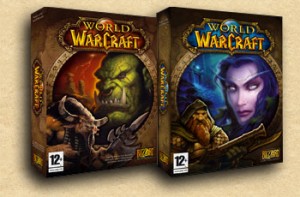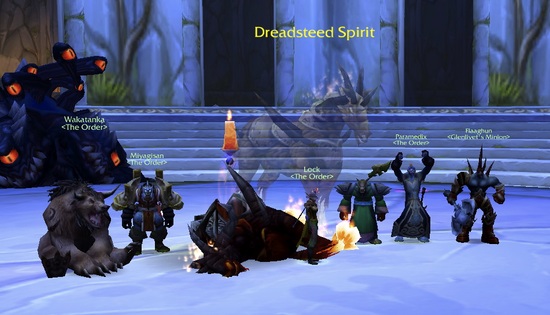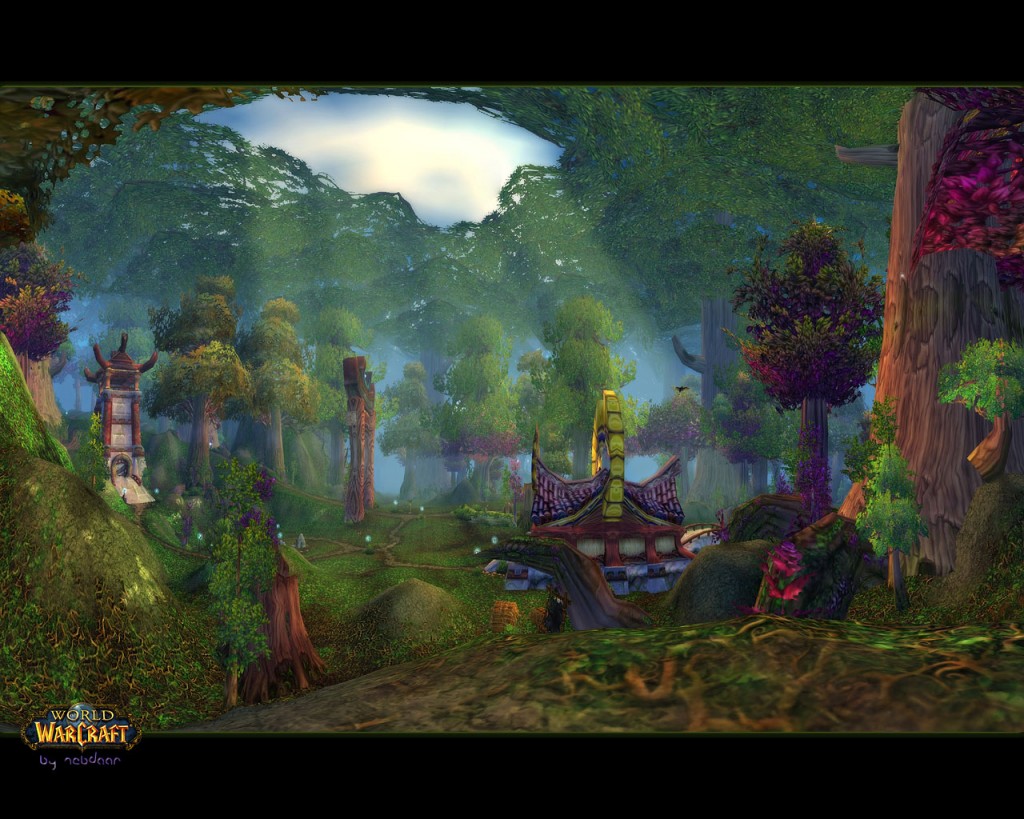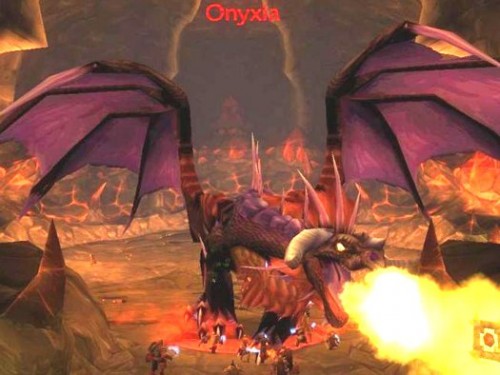In this detailed post series, I discuss the evolution of the five World of Warcraft endgames from both a player and game design perspective.
Why Endgames – and a bit on leveling
For the most part, leveling a character in Vanilla World of Warcraft wasn’t too different than in most single player RPGs. Sure, helpful or hurtful players sped up or slowed down your leveling rate, but you rarely required others. Dungeons were an exception, as these always required five players, but you didn’t need dungeons to keep leveling. In fact, while the dungeon blue gear was much better than the typical leveling gear, dungeons slowed you down. The XP was split among players and the two hours it took to assemble a party and the frequent wipes made them inefficient. In those early days, experience came from only two sources: killing monsters and quests. Everything was slow compared to where it is now. Quests were far apart. Mounts came at level 40. Flight points were rare.
It took me approximately 400 hours to level my Warlock from 1 to 60. It felt epic. I never looked at a guide, or searched the web, but took the game as it came. Aside from the occasional frustration, progress was slow but steady. Things were tuned much harder back then and catching a second (or, God forbid, a third) add (additional monster) could mean certain death. Graveyards were spread far apart. Sometimes it was even easy to get lost on the corpse run back to a dungeon (like Black Rock Depths).
But at 60, this steady rate of progress took a huge downshift. Why?
Even at launch, WOW was a big game. So big, that as a game creator my jaw dropped at the sheer number of zones, quests, mobs, items, dungeons, etc. Still, it took years to make. There is no possible way, no matter how much money Blizzard spent, that they could create leveling content at even close to the rate at which players could consume it.
So they had to slow you down and design “endgame” content that was slower to consume.
General Questing
Back in 2005, questing at 60 was a waste of time unless you merely loved the lore. Quests didn’t even award (meaningful) gold on turn in. They rarely earned reputation. They were pretty useless except for the obsessive. Without achievements, it was hard to judge how many you had even done.
Class Quests
One exception to this, and short lived, were class specific quest chains. Warlocks had class specific quests every 10 levels and at 60 could quest for a special demonic pet called the Doomguard and to earn a special epic (i..e. fast) mount. Both of these chains were fairly difficult and required help from others but occupied me for a few days as a new level 60. Too bad the Doomguard was — at that time — utterly useless (except for torturing newby Aliance) and the Dreadsteed cost a fortune in gold. Still, these were cool chains.
Key Quests
In vanilla, most of the level 60 dungeons and the three early 40 man raids (Molten Core, Blackwing Lair, and Onyxia’s Lair) all required keys. As a brand new 60, I didn’t even understand what raiding was, so I’ll come back to that, but it took a bit of work to grind out all the quests needed to get the keys for Scholomance, Stratholme, UBRS, and Dire Maul. These often involved normal questing mixed with dungeon runs and had quest chains that strategically bounced back and forth between continents (adding 30 minutes of travel time to each leg). The UBRS chain was hard enough that despite the instance’s popularity owners of the key were few and far between (each group only needed one key holder).
5 Man Dungeons
For a short while, the five man dungeons represented a decent source of level 60 blue gear, which was much better than quest greens. Unfortunately, the return on investment was often very poor. Guild runs were great, but my guild was a tiny group of real life friends and rarely went. PUGs (Pick Up Groups of random players) were another matter entirely. In general, it took perhaps an hour or two to recruit a tank and healer and get them all to the desired dungeon. Then one of two things happened: 1) you spent about 2-3 hours making really solid process through the dungeon or 2) you spent 3-5 hours wiping constantly and eventually one or more people left and the monsters respawned.
In the first case, you had a great time and might even earn some needed loot or clear out a few difficult dungeon quests. In the second, you almost certainly wasted the time completely and spent a bunch of gold on repairs and materials. As you got more and more blue gear the odds of winning something you wanted declined. Combining this with the high odds of “option 2″ in random PUGs meant that few players wanted to run level 60 dungeons with strangers.
Those of you who never played Vanilla or Burning Crusade may not really understand what the old five man dungeons were like for people in blue and green gear. They were all gigantic, with 5+ bosses and obscene amounts of trash. It was easy to get lost. The tuning was such that each individual pull required crowd control to have any hope of success. Accidentally dragging in a PAT or second group was almost always suicide. Monsters respawned fairly quickly which meant that dying could involve clearing a second (or third) time. Only a Warlock Soul Stone or Shaman Ankh could prevent a long corpse run after a wipe. Druids healers didn’t even have a resurrection spell! Replacements had to travel across the world to enter the dungeon (could take 30 minutes). Summoning could not be done inside the dungeon and required carefully exiting the whole party so the Warlock could summon.
On the plus side, the dungeons were really cool and involved all sorts of special setups.
PVP
The early honor system rewarded extreme investments of time spent grinding battlegrounds. PVE and PVP gear wasn’t very different in those days, so there were some decent blues that could be earned by reaching high levels of reputation with one of the three battleground factions. In practice, only Alterac Valley made this reasonable, involving a grind of “only” several weeks. The other two, could take months. If you focused your PVP time intensely into a short couple of weeks you could get your honor rank up and earn a few mid range blues. The epic (and quite awesome) sets were reserved only for the top ranks. The rank of High Warlord (he who PVPed the most on the server for the Horde) required an investment of approximately 16-18 hours a day for 6-9 months. Hardly casual.
Grinding Materials and rare Objects
Some players, me not included, seemed to enjoy grinding out various materials for trade skills, sale, or their guilds. This usually involved mindlessly killing a particular class of mob for extreme lengths of time (hours was just the beginning). An alternative variant was traveling around on your mount in a set route collecting either herb or mining nodes.
One variant of this, which I did occasionally do, was grinding for rare vanity pets. For example, the little colored whelplings which dropped 1 in a 1000 from various dragonkin. It took several hours to get lucky and collect one of these rare pets.
Professions
WOW professions have never been much of a minigame and instead just a straightforward grind. In Vanilla, the designers did add some interesting choices and splits into a couple of them. Like the goblin/gnome engineering divide. My main took Alchemy/Herbology, which while very useful, has always been one of the most boring combinations in the game. Across five expansions they almost never added anything interesting to either profession, Burning Crusade being a minor exception.
Most crafting skills involved some rare/epic component useful/necessary for high end raiding. This usually involved an obscene grind. Getting the Thorium Brotherhood reputation up for Blacksmithing, for example. With Alchemy, the original flask system made another brutal illustration. The recipes came only from raid bosses. The ingredients were very rare and worst of all, flasks, which are after all a consumable, could only be made at the two special Alchemy Labs: one deep in Scholomance, the other, even more cruelly, several bosses into Blackwing Lair (a difficult second tier 40 man raid)!
The Easy Raids
Prior to winter/spring 2006, it was possible to “raid” Scholo, Strat, LBRS, and UBRS with 10-15 players. The dungeons weren’t tuned any differently in these modes, so were MUCH easier than normal 5 man runs (UBRS was never possible 5 man, but required a minimum of ten). You couldn’t complete most quests this way, but you could get a shot at the blue loot. This was by far the easiest and most efficient way to get blue dungeon gear as 10 man raids rarely wiped (except in UBRS). They usually involved an easy mindless zerg with low odds of getting gear. Loot dropped infrequently, and only one blue per boss.
UBRS was a special exception, as it was harder, even with 15 people, and had slightly better loot. It was also very popular, vital for the Ony Key Chain, and so groups were readily available. Occasionally — very occasionally — it even dropped some mediocre epics.
The Class Epics
The designers created specialized quest chains that allowed many classes to get one or two epics, often head gear. In addition, there were a few weapons like the priest staff, the hunter bow, or the warrior sword (as usual, DPS casters got nothing). This gear was better than dungeon blues, but not nearly as good as the raiding epics. The grinds were also pretty obscene. In Vanilla, when they said epic, they meant it! The helmets all required the “pristine hide of the beast” an exceedingly rare drop from The Beast in UBRS (available only to max level skinners with a special rare tool) plus a whole bunch of rare materials from other dungeons. Several weeks of dungeon grinding were required to make one item.
The weapon quests, which were all tied into raiding, were difficult, but regarded by many as super cool and rewarding (after you finished).
Reputations
Reputations have come a long way in WOW. The early reps combined both obscene grinds (like kill several thousand Furblogs or run Strat and Scholo at least 150 times) with an extreme paucity of rewards. Getting exalted with the Argent Dawn was a tedious weeks (or months) long process of endless dungeon runs, yet in the end, you merely got a shoulder enchant that added +5 chromatic resist. At revered, you could pick a single school of resist.
Other factions offered even less reward. Timbermaw took weaks for one (more or less) vanity item! However, by the later days of Vanilla, the AQ and ZG factions did offer some real gear — but were tied to raiding and retained the brutal grind.
Getting into a Raiding Guild
A few weeks after turning 60, there was only one way to make any real progress on your character: get into a real raiding guild. This made for a clear and sharp divide between raiders and non-raiders. A quick glance at a character told the tale. Raiders were sprinkled (or covered) in purple.
But raiding involved 40 (or occasionally 20) player groups with a particular class composition. The raids themselves were exceedingly difficult even with everyone present. Reading strategies and installing and using an external voice chat program were mandatory. Guilds at this time usually had web pages and formal applications. The armory wasn’t yet available, so you had to list all your gear and progress, and even fill out a couple of essays.
Acceptance, if it happened, was provisional. Guilds had rules and policies and as a new member you had to tread lightly or get kicked out. “Dragon Kill Point” systems ensured that newbies had a very low chance of getting gear.
The Ony Key Chain
One of the most loved and reviled things about Vanilla was the Onyxia Key Chain. In order to enter this single boss 40 man raid, you had to atune your character and doing that meant finishing one of the most arduous quest chains in the game. Having completed it was often a requirement for entry into raiding guilds.
The Horde version of the chain began with my most hated quest of all time: Warlord’s Command. This required you to run LBRS 5 man several times. Without guild help, this was brutal. LBRS could easily be 4-5 hours and offered subpar rewards. No one ever wanted to run it except for the Ony or UBRS keys. I spent a good ten days continually recruiting groups. Several times I even got into the place only to wipe and fall apart 3-4 hours later. One of the drops was even a single scroll hidden in one of four random locations which only one party member could get. Only the mercy of two of my real life friends helped me finish this rite of passage.
And after that, the quest chain bounced you back and fourth between a remote spot on the eastern continent and Rexxar, an elusive quest giver who wandered two whole zones on the western. In between, you ran UBRS again and again for various stages of the chain. Other than Warlord’s Command (and an equivalently brutal Alliance version in BRD), it wasn’t really hard, but it was a test of will power and perseverance.
The Middle Raids
An important thing to understand about all raids in WOW (particularly Vanilla) is that each player could enter each one only a single time each week. This was called the lockout. Once you became “bound” to a raid ID for the week that was your instance until next Tuesday. This meant that one of the worst things that could happen was to be accidentally bound to a raid with a group that was incapable of making significant progress. If you did, you blew your shot at those bosses for the week. Also bad was to join an existing raid that had already killed the easy bosses, as you would become bound and miss those bosses for the week.
While I was leveling, Blizzard released the first of Vanilla‘s two 20 man raids, ZG. In January of 2006, they added AQ20. These raids were easier than their 40 man brethren and certainly getting a group organized was simpler. The gear was mixed blue and epic and in both cases tied in a complex faction to the dungeon reputation. Most serious raid guilds ran them as “off night” content when a big raid wasn’t going. Getting into the group was easier. Killing the bosses sometimes easier. But the rewards weren’t great. The gear was odd and you often had to run the place again and again for weeks to have enough rep to turn in the better rewards. Some of the fights were pretty hard too and interesting gear was often offered by optional bosses that were very difficult to summon — meaning groups rarely bothered.
Molten Core
Molten Core, or MC, was the bread and butter of Vanilla raiding. It had LOTS of bosses. It dropped the whole Tier 1 set, three epics per boss without constraint. It was fairly easy with 40 people who knew the place. The atunement was easy. Our guild sometimes had trouble filling all 40 spots and so that was a bit of a problem. The instance was also VERY long if you weren’t efficient. There were a lot of bosses and immense swaths of trash, so sometimes it took two nights, which meant clearing the trash twice! The final boss, Ragnaros, was hard. He required high fire resist and was a serious DPS check, but he did drop the T2 pants.
MC was the key to getting seriously geared in Vanilla. If your guild ran it every week and actually cleared to Domo (the boss before Rag) then your odds of getting some serious T1 loot were high. It was a serious time commitment, scheduled (for example, 6 to 10pm on tues and wed) but in the early days, before it devolved into a six hour slog through solid orange, it was damn fun and felt seriously epic.
Ony
If MC was the bread and butter, Ony was the creme. As a single boss behind only four trash mobs, she dropped at least four T2 epics including two T2 helms. This was the best gear that was moderately accessible. Ony wasn’t even that hard, but she was random. Her second of three phases made or broke the whole event. She flew around above periodically sweeping half her chamber with “deep breath.” Sometimes it didn’t happen, sometimes once, sometimes three or four times. One hit you could survive, particularly if you swigged a fire protection potion in advance. Two or three? Forget it. If most of the raid lived to phase three, you’d probably kill her. If someone didn’t pull agro or get themselves knocked into the whelp caves, therefore bringing out a fatal brood of her spawn.
The RNG (Random Number Generator) was killer. My guild vanquished Ony every week in 2006. She only dropped the Warlock helmet twice. Once on my birthday when I wasn’t there and once in October (while I was sneaking the raid in at work). I wanted that hat (the Nemesis Skullcap) for 9 months. Getting it was perhaps the biggest high of my WOW career (tied with achieving Hand of A’dal).
Blackwing Lair
Raids prior to BWL were hard, but didn’t require all that much coordination. Yeah, there was stuff to avoid, and tanks had different jobs, but for the most part DPS had to stay alive and do as much damage as possible. BWL was something else entirely. The first boss had no trash, but about 50 adds at a time. Different groups had to run around in a 100+ mob free-for-all kiting and managing this unwieldy and dangerous host while some designated “controllers” mind controlled a dragon and broke a bunch of eggs with special abilities. If somehow you had the coordination to survive this, it switched into a more or less normal boss fight after 10 minutes.
This opening, plus MC’s Rag and the later BWL bosses, separated the hardcore from the merely competent guilds. We worked on Razorgore (the first boss) for about two months before downing him. Nothing released in later patches geared you up to overcome the level of coordination needed for BWL. Guilds had to be disciplined to progress. You needed to raid 4-5 nights a week. To show up on time and have forty people of the right mix there. They needed to be the same people and they needed the patience to wipe again and again and again and again. They needed to watch videos and prepare, to pop flasks and pull out all the stops. Special mechanics gated certain bosses. Nefarion (the final boss) required that everyone in the raid have Ony cloaks, which could only be made from scales earned from the earlier dragon. It took half a year to make enough for everyone in the guild one, and only if people didn’t leave!
The Gates Open and Changes Occur
In early 2006 Blizzard changed a bunch of stuff in the endgame, most, but not all for the best. They added some epic quests. They discontinued the “raiding” of the normal dungeons, and they opened AQ20 and AQ40, two new raids. The dungeon changes actually made the end game harder by removing the easiest route to blue gear. The 5 mans got a hair easier, but still remained huge time sinks.
AQ20 gave midlevel guilds like ours something else to do and a way to get more approximately T1 gear. We dabbled in AQ40 but it wasn’t manageable by guilds that hadn’t farmed BWL.
Naxx
In May, Naxx launched. This monstrous 40 man raid was probably the most difficult ever made (the only other contender being Sunwell). Only the elitist guilds that had farmed through BWL and AQ40 could possibly make progress there. Its groundbreaking encounter design required extreme cooperation. Many of you probably saw it years later in its much easier 10 and 25 man Lich King incarnations.
Controlling Progress
You might wonder why I keep using the worlds hard, brutal, tedious etc. How come 10-15 million people played this game? Now, it was a little less during Vanilla (perhaps 7-9 million) but WOW was incredibly fun. Yes, often hard and frustrating, but immensely addictive. And honestly, it was much less frustrating than prior MMOs, which had been designed with the punitive model Let’s speculate on WHY the designers did what they did with the endgame.
MMOs have a decent number of hardcore players. Some are willing to spend crazy amounts of time and energy on things and some have a very high level of skill. Yet, this isn’t most people, and so the designers wanted an endgame that could keep people playing for months or years regardless of their skill level.
The raid content served the hardcore. It required skill, coordination, practice and all that. It was/is also some of the most difficult content to make from a development standpoint so the sheer amount was very limited. Therefore, to make it last for the elite, it had to be very hard. Progression was further “slowed down” (or more gameplay created, depending on your perspective) by regulating the amount of boss kills and per boss loot. If the current tier has 9 bosses that means that approximately 30 epics drop for each guild of 40 players each week. This means one per player every week or two at best (there is a random factor and as you get better geared it gets harder to get that last specific item). It then takes a couple months for a raid to fully gear from a tier. Hopefully, by then, the dev team has time to build a new raid. In practice, for guilds who weren’t as good as the difficulty standard, it was far far slower (and more frustrating).
The non-raid content was designed for the more “casual” but because of the existence of those willing to spend 100+ hours a week on grinding, each individual route to progression needed to be incredibly slow so they couldn’t power through it. Blizzard had not yet transferred the raid lockout concept to this arena as it would in Burning Crusades (i.e. dailies, but I’ll discuss that when I post about the expansion). So, their solution was gating by sheer time investment, and a steep one at that. Some crazy people (High Warlords I’m looking at you!) rose to the occasion!
Concluding Thoughts
While the Vanilla endgame did have its share of problems: a lack of content for non-raiders, frustration factors, tank shortage, class imbalances, broken specs, extremely steep grind curves, and very high difficulty levels, it was overall pretty damn successful. The designers built a truly stupendous amount of content and invested heavily in unusual and “one-off” quests and details. Compared to later expansions, items were highly individualized, classes varied, factions different, and the game was filled with all sorts of unique quests and features. This, combined with the high difficulty, lent things an extremely epic and deep feel.
The long saga continues with thoughts on The Burning Crusade…
| WOW Endgame series: Vanilla, Burning Crusade, Lich King, Cataclysm, and Pandaria. or read about Mists of Pandaria leveling. If you liked this post, follow me at: My novels: The Darkening Dream and Untimed |



























